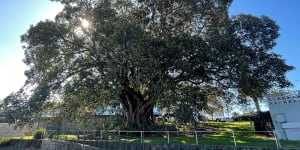As councils grapple with a recent surge in illegal tree vandalism and the worsening impacts of climate change,the management of trees that provide shade and shelter,and can reduce surrounding temperatures by up to 2 degrees,has come under intense scrutiny.

This Moreton Bay fig tree at Water Street,Sans Souci,was placed on Georges River Council’s Significant Tree Register.Georges River Council
Georges River Council,in Sydney’s south,has just exhibited its revised tree management policy. It was drafted “with a renewed focus on the enhancement and management of trees to facilitate the delivery of council’s adopted 40 per cent urban canopy target”,a spokesperson said.
Notably,the new policy focuses on increasing the number of trees on private property,since “the outlined canopy target cannot be reached by increasing canopy cover on public land alone”,they said.
“We really value protecting our local flora and fauna,” Mayor Sam Elmir said. “We believe that this Significant Tree Register is a step in the right direction to safeguarding Georges Rivers’ trees from any adverse impacts that may be caused by the urban environment.”
Residents in the local area were invited to contribute trees they liked to the register,and a draft register was exhibited for public comment at the beginning of 2022. The council will now finalise the list before publishing it later this year.
Most councils have also created significant tree registers – lists of trees in their LGAs that have unique cultural,historical,aesthetic or environmental value.
Trees that are listed on Randwick City Council’s Significant Tree Register,for instance,can only be removed or significantly pruned after development consent is given by the council,in addition to the regular tree permit applications.
Woollahra Council adopted a similar register two years ago,amending one it had in place since 1991.
“In recognising the Municipality’s Significant Trees,meaning can be brought to the past,allowing a richer understanding of the present,” the document says. “The concept of heritage is always changing with time and the way people interact and assign value to their surrounding environment.”
But councils require great foresight when considering what trees to put on the registers:given trees are living,changing organisms,councils consider what trees are likely to become “significant” in the future.
“Immature trees of little historic and visual significance today may in time achieve great significance and value to the community,” Woollahra Council’s registry document adds.
The City of Sydney,one of the few councils to have an interactive registry available online,has 2674 trees listed as significant and worthy of protection.
